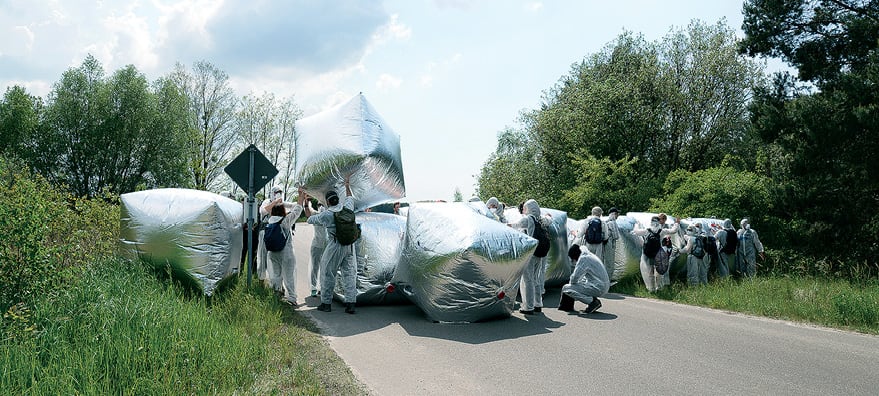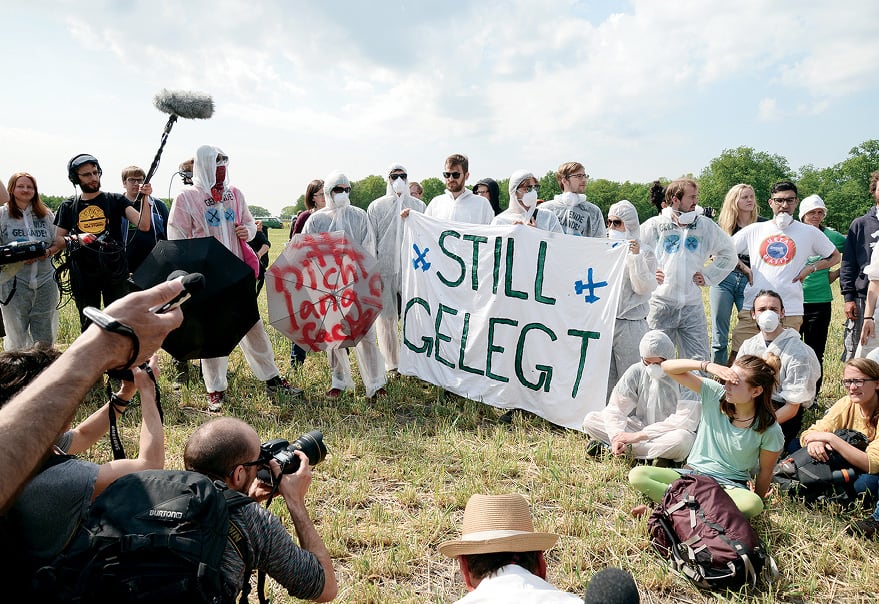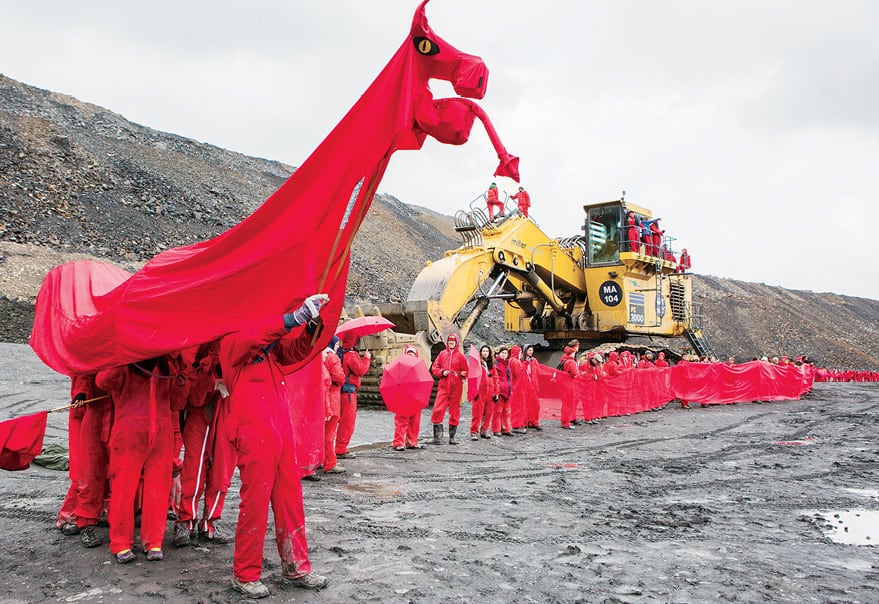The protest was called Ende Gelände (Here and no further) — and it was direct action at its best. Not a symbolic gesture that just tells a story and makes an injustice visible, but an action that targeted the very source of the problem and stopped it in its tracks … Ende Gelände was a collective act of resistance that for once felt proportionate to the scale of the emergency: catastrophic climate change.2The Paris Agreement announced at the conclusion of the United Nations Climate conference, COP21 (2015), may well be an unprecedented ‘collective Letter of Intent’3 amongst world leaders but many commentators are sceptical of its capacity to deliver the necessary drastic cuts to CO2 emissions needed to avoid disastrous temperature rises.4 Immediately after COP21, global climate campaigner 350.org announced May 2016 would be the month to ‘Break Free from Fossil Fuels’, urging activists to organise actions around the world promoted with images from Ende Gelände. For the second Ende Gelände, this year more than four thousand people converged in the Lausitz in the east of Germany for a weekend of actions (13–15 May) in the coal pits operated by Swedish state-owned energy company Vattenfall. In an effort to shift towards renewables, Vattenfall announced it would sell its lignite business to a Czech consortium of energy companies, EPH (Energetický a Průmyslový Holding), who would continue to operate the mines until 2045. In response, Ende Gelände declared itself to be ‘the investment risk’, telling potential investors that coal assets come bundled with a ‘wildly determined resistance movement’.5 Reflecting on my experiences with Ende Gelände, this text reviews its strategic use of media, and the aesthetics and innovations arising within climate justice movements following COP21.
‘Actions live off the images’
So said one of the plenary speakers at the Lausitz Climate Camp, following the first day of action. On the previous night an action primer video, a short documentary following activists from camp to pit to police van during last year’s Ende Gelände, was screened in the camp’s central circus tent. Over the following nights photographs and video ‘daily rushes’ of the day’s actions were screened, allowing participants to collectively review, self-reflect and, arguably, intensify experiences. After the first day of action, Malcolm Kratz’s drone footage of protesters entering a coal pit and occupying a coal digger raised cheers from the audience. The aerial footage gives a disembodied sense of the scale of the mine, its machinery and the mass of protesters occupying this landscape. Developed as a military technology, it may seem novel that drone-mounted cameras have become a common video production tool, yet in civil disobedience actions they can be doubly deployed for counter-surveillance. Crowded into the tent after the second day of action, we watch an edit of activists entering Schwarze Pumpe Kraftwerk. On screen a throng of masked and hooded white figures, laden with backpacks and clutching bags of hay, chant anti-capitalist slogans as they scale the fences of the sleek silver facility. Riot police arrive to break up the crowd and in one sequence a young woman attempting to attend to another protester, painfully restrained in a head lock, is delivered a short sharp punch to the head by a masked armoured cop. As she drops to the ground, a palpable shock registers across the audience, many of whom had only hours before escaped this scenario frustrated, injured and confused. Videos such as these, quickly assembled after a day of action, appear as militant-styled propaganda. Others, such as the ‘wrap-up video’, produced by 350.org, make use of post-production techniques that are reminiscent of extreme sports promos or music videos and, as one participant commented, are ‘maybe even a little too slick’. These videos depict actions as being triumphant, even heroic, and reinforce their game-like aspects. Is it ironic that the Ende Gelände wrap-up video appears on its website beneath the heading ‘Mission Completed!’?I could imagine myself doing that
Arresting images have played a role in publicising, aestheticising and bringing people to Ende Gelände. Many people I met would recall these photographs when describing their interest in the movement, saying things like ‘I saw the pictures on Facebook. I wasn’t sure what it was but I knew I wanted to be a part of it’, and ‘The images tell the story. I could imagine myself doing that.’ One can discern an emergent visual language amongst the climate justice movement, with certain motifs reappearing in several actions that were part of Break Free. The action that launched the campaign, End Coal Now! was organised by Reclaim The Power at Ffos-y-Fran, Wales, in the UK’s largest open-cast coal mine. Here demonstrators wore red boiler suits, distinct from Ende Gelände’s white, and formed snaking ‘red lines’ with long banners across the landscape. Red lines, a meme that emerged during the protests surrounding COP21, represent the limits for a just and liveable planet that cannot be crossed. Also on hand were umbrellas, a prop that came to mark the sit-in protests in Hong Kong in 2014, which were used in last year’s Ende Gelände to provide shade in the coal pit. During COP21 they became a ubiquitous and subversive implement, quickly expanded to display slogans at a picket line or form a temporary blockade. Other, more militant activist tools, such as lock-on pipes and tripods, can also be seen in Reclaim the Power’s imagery. The appearance of a large red dragon puppet, a creature of local Welsh folklore, is featured in many photographs documenting performances staged for the camera that have become common to protest actions. To some, the use of symbolic props and staging may seem ‘folksy’, yet strategically these images are press-friendly and appeal to audiences who are put off by confrontation. In Australia, the blocking of the world’s largest coal port in Newcastle was a significant action aligned with Break Free. On Sunday 8 May 2016, around two thousand people gathered at Nobbys Beach for a rally, as a fleet of several hundred kayakers and other watercraft filled up the harbour, preventing ships from entering or leaving. Another group of approximately sixty activists, also wearing white boiler suits marked with red ‘Xs’, blockaded a rail line. Amongst them were a group of Climate Guardian Angels, a group of women from a range of ages who are part of the theatre troupe ClimActs. Their ethereal appearances drew tourists and distracted security whenever they ‘descended’ in Paris during COP21. In Newcastle they put their bodies on the line, bestowing a sage-like presence to the non-violent disruptions. On this Mother’s Day, the angels invoked populist, Christian notions of ‘divine mother nature’ — predominantly white women as nourishers, protectors and custodians — which is undeniably problematic in the settler-colonial space of Australia. Nonetheless, a photograph of an angel lying across the tracks, facing the camera as three burly policemen, their backs turned as they drag another uncooperative bundle of feminine feathers away, has circulated widely, derailing recent measures by the New South Wales government to criminalise protest.6 The documentation of these actions indicates a significant presence of Aboriginal people who effectively challenge the Anglo-Christian notions of custodianship that the angels perform. Photographs of a ceremony and rally flanked with Aboriginal and Torres Strait Islander banners, emphasise that climate justice is not simply about a popular shift into renewable energy, but is a movement driven by demands made by the very people whose land has been stolen and exploited through processes of colonialism, industrialisation and mineral extraction.Weapons of Tactical Frivolity
Another innovation in activist techniques and aesthetics has been the shiny silver inflatable cubes, often described as cobblestones or barricades, developed by Artúr van Balen and the collective Tools For Action (TFA). These air-filled sculptures, now used in demonstrations around the world, became a design icon when featured in the exhibition Disobedient Objects (2014) at London’s Victoria and Albert Museum. Van Balen describes the cubes as a ‘secret weapon of tactical frivolity’. When tossed around a crowd they are capable of transforming protest antagonisms into a ‘highly interactive and playful event’, or can otherwise be used defensively to protect demonstrators from police batons.7 In the lead up to this year’s Ende Gelände, TFA held a series of workshops around Europe, aiming to have around one hundred cubes ready for action in the Lausitz. Isa Fremeuax, of Labofii, spoke of the silver cubes making ‘interesting images’, echoing comments I overheard in the press tent, in which they were described as looking ‘fake’, like a 3D rendering in the aerial drone video. Certainly the strange ‘Martian landscapes’ of the coal pits are key to Ende Gelände’s visual language and appeal. So it’s possible that the novel appearance of the cubes in these and other scenarios are not only part of multi-stage, on-the-ground actions but also inform a media-strategy. Van Balen claims that clichéd imagery of smashed windows, overturned cars and police clashes portray protesters as anti-social and criminal. Giant reflective cobblestones, however, over-exaggerate this image of ‘stone throwing trouble makers’ to provide reporters with a different perspective on protest culture, one which emphasises collective creativity and play.8 Some activists are critical of the focus on novelty, the carnivalesque and the ‘gamification’ of recent mass actions, which they say have led protests to become something of a ‘middle-class distraction’, like a music festival or ‘activist tourism’.9 As economic sociologists Nick Srnicek and Alex Williams argue in their recent critique of ‘folk politics’, ‘[t]his is politics transmuted into pastime — politics-as-drug-experience, perhaps — rather than anything capable of transforming society’.10 Others argue that organising popular mass actions brings people to the movement and enables the kinds of activities that are only possible with a crowd. For many attending Ende Gelände this was their first act of civil disobedience, perhaps even their first protest, and one cannot underestimate the strength of friendships made in the ranks of struggle.11 However, to draw once again on Srnicek and Williams, we might ask that following the intensity of the actions and the inevitable return to ‘normal life’, will this shared sense of unity not simply dissipate?Geophysical Actors
The different tools, techniques and strategies deployed in the climate justice movement reveal a field of innovation, characterised by a strategic combination of novelty and militancy that belies its often folksy aesthetics. At the conclusion of its recent campaign 350.org published a wrap-up video, Break Free, 2016: The Movement Steps Up, a patchwork of local actions composited together as a coherent whole. With its sweeping shots of crowds, rallies, banner drops, occupations and lock-ons, edited to an emotive music soundtrack, it resembles a motivational corporate video. Underscoring phrases such as ‘civil disobedience’ and ‘moral witness’, the video affirms that tens of thousands of people are ‘standing up’ in a campaign that spans six continents. Yet despite the video’s insistence of global mass action, thirty thousand people on a planet of more than seven billion hardly seems proportionate to the scale of the emergency. Srnicek and Williams are critical of protest cultures’ often sloganeering and reductive logic, which they claim is insufficient to address the ‘complex systems’ of anthropogenic climate change, globalisation and international politics. They even advise activists to use computer modelling to find the most effective points of leverage for protests and blockades to ‘avoid scattershot and ineffectual political action’.12 Yet in 2012, Brad Werner, a professor from the University of California, San Diego used computer modelling to arrive at a different conclusion — that direct actions such as ‘protests, blockades and sabotage by indigenous peoples, workers, anarchists and other activist groups’ were indeed the likeliest factor capable of inhibiting planetary climate change.13 Werner explains that organised forms of resistance to the ‘dominant culture’, if understood as sources of ‘friction’ or ‘dissipation’ in dynamic systems, are not only cultural phenomena but are ‘really a geophysics problem’.^14 If we understand climate activists as geophysical actors intervening in complex systems, in which marginally different inputs can have widely divergent effects, is it not possible that relatively few actors undertaking strategic actions could have significant planetary impacts? That is, if we have time. In lieu of precise networked organising, social movements are charged with bringing issues to light, applying pressure to corporations, states and political parties, and developing popular platforms for resistance. A struggle over the means and control of energy production seems to have pre-empted the ‘climate wars’. These are conflicts with the potential to escalate as access to arable land and water become increasingly scarce and global inequalities worsen.15 Thus, it seems that one of the most urgent, challenging and visible fields for artists to be working will be in strategic, creative and globalised civil disobedience. The final sequence of the Break Free wrap-up video features Kratz’s drone footage of a crowd advancing across a field at Ende Gelände. As the drone rises, the shot widens rendering each participant a pixel, a contrast to the personable faces on blockades and marches that comprise much of the montage. The clip lingers on this abstract machinic vision from above, of the mass filtering down and extending beyond the frame. It leaves an impression of the movement as form, both a historical and geophysical force. The new aesthetics of planetary climate justice.From December 2015 to June 2016, Sumugan Sivanesan was a DAAD resident at the University of Potsdam Department of Cultural Studies researching ‘Urban eco-politics in the Anthropocene’. His research blog is: http://theshadowofthefuture.wordpress.com.
1. Giacomo D’Alisa, Federico Demaria and Giorgos Kallis (eds), Degrowth: A Vocabulary for a New Era, Routledge, 2014.
2. John Jordan, ‘The day we stopped Europe’s biggest polluter in its tracks’, The Guardian, 27 August 2015, http://www.theguardian.com/commentisfree/2015/aug/27/europes-biggest-polluter-protesters-lignite-mine-germany-direct-action.
3. Marlowe Hood, ‘COP21: Less than meets the eye’, AFP Correspondent, 21 December 2015, http://blogs.afp.com/correspondent/?post/cop21-less-than-meets-the-eye.
4. See, for example, Deputy Director of the Tyndall Centre for Climate Change Research, Kevin Anderson in his blogpost ‘The hidden agenda: how veiled techno-utopias shore up the Paris Agreement’, kevinanderson.info, 2016, http://kevinanderson.info/blog/the-hidden-agenda-how-veiled-techno-utopias-shore-up-the-paris-agreement.
5. See http://breakfree2016.org/ . On the Ende Gelände campaign see Dorothee Häusserman, ‘The blind spots of the German energy transition — 2nd round for Ende Gelände’, The Norwich Radical, 13 April 2016, http://thenorwichradical.com/2016/04/13/the-blind-spots-of-the-german-energy-transition-2nd-round-for-ende-gelande.
6. ABC News, ‘NSW increases anti-CSG protest fines for trespass to $5,500, up to seven years jail’, 16 March 2016, http://www.abc.net.au/news/2016-03-16/nsw-increases-penalties-for-csg-protests-on-gas-sites/7249372.
7. van Balen cited in Steffi Duarte, ‘Inflatables for protest: An interview with Artúr van Balen/Tools for Action’, V&A Blog, 3 July 2014, http://www.vam.ac.uk/blog/disobedient-objects/tools-for-action-interview-with-artur-van-balen.
8. van Balen cited in Johanna Rainer, ‘You cannot give instructions to a gigantic inflatable’, truthisconcrete.org, 13 April 2012, http://truthisconcrete.org/interviews/you-cannot-give-instructions-to-a-gigantic-inflatable.
9. For example see Climate Games, http://www.climategames.net.
10. Nick Srnicek and Alex Williams, Inventing the Future: Postcapitalism and a World Without Work, Verso, London and New York (e-book), 2015, p. 17.
11. See Sian Sullivan, ‘We are heartbroken and furious! Rethinking violence and the (anti-)globalisation movements’ (working paper), 2004, http://eprints.bbk.ac.uk/6067/1/wp13304.pdf.
12. Srnicek and Williams, p. 245.
13. Brad Werner, ‘Is Earth F**ked? Dynamical Futility of Global Environmental Management and Possibilities for Sustainability via Direct Action Activism’ [abstract], 2012, http://adsabs.harvard.edu/abs/2012AGUFMEP32B..04W.
[^15]: McKenzie Wark, ‘Geopolitics of Hibernation’, 9th Berlin Biennale for Contemporary Art: Fear of Content, 25 April 2016, http://bb9.berlinbiennale.de/geopolitics-of-hibernation.


